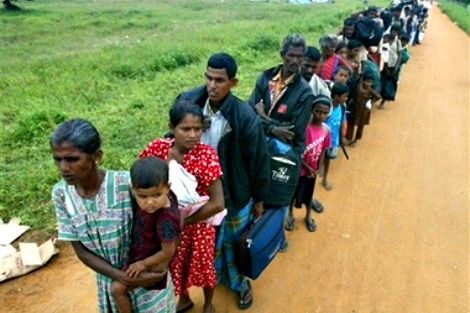Sri Lankan Tamils are not refugees; They are Brothers!


People’s from our adjoining countries came to our country as both refugees and intruders. The Parsis, who followed Zorastrian religion from Persia, present day Iran, emigrated to India due to the Islamic occupation of Persia.
They worship the God of fire and perform the ritual of sacrificing their bodies to eagles after death.
When the Parsis who had taken refuge in India sought refugee with the Indigenous kings of India, one of the kings pointed out to a glass of milk and indicated that there was no place for them to settle there. But the rumour is that the leader of the Parsis humbly persuaded the Indian king by mixing a little sugar in a glass full of milk and claimed that just like how sugar add sweetness to this milk, the same way we would strengthen the Indian culture.
The Parsis have become an inseparable part of Indian national culture for the past 3 centuries. The Parsis follow their traditional Zorastrian religion and cult. There is no hindrance for the Parsis in India. Big businessmen like TATA, scientists like Homibaba, many freedom fighters and politicians like Feroz Gandhi, the husband of the late prime minister of India Indra Gandhi are adding strength to the Indian nation.
Parsis who took refuge in India have become its valued citizens. There are over ten lakh parsis living as Indians in areas including Gujarat and Mumbai. During the Indo- Pakistani partition, 6 crore Indians living as aborigines in Pakistan became refugees. Of these, Indian native Hindus, including Punjabis, Sikhs and Sindhis were expelled by the Pakistanis.
About 2 crore Hindus took refuge in independent India from Pakistan. The newly formed Nehru- led congress government of India found it very difficult to provide much-needed assistance, accommodation and medical assistance to the asylum seekers. It has granted asylum to Sindhis, Punjabis and Sikhs in India, providing them with as much space, employment and education as possible. Even today Punjabis, Sikhs and Sindhis live peacefully as Indians.
After 2 lakhs Tibetans took refuge in India with their Buddhist leader, the Dalai Lama, as the communist country China conquered Tibet, the so-called roof of the world.
India, which has given asylum to the Dalai lama, has set up Tibetan settlements in Dharmasala in Himachal Pradesh and Hansur in Karnataka.
The government of India has been providing economic assistance to Tibetans by granting them refugee status, as well as reservation in education and employment. We still have enemity with communist China because we gave refugee to Tibetans who follow Buddhism.
Tibetans living here have also been providing support to the Tibetan liberation movement led by the Dalai Lama. There is no impediment to the unity of India or to the Citizens of India by the Tibetans.
During the period between 1970-71, a large number of Bangladeshi muslims entered India as refugees due to the brutal repression carried out by west Pakistan in Bangladesh, i.e., in East Pakistan.
The Pakistani military has brutally raped and massacred the Bangladeshi people who were trying to get liberation from Pakistan. Millions of Bangladeshi muslims have taken refugee in India.
In 1971, the then Prime minister Indra Gandhi won the war against Pakistan to save the muslims of Bangladesh from Pakistan and won independence for Bangladesh.
Bangladeshi Islamists are illegally infiltrating into India due to the political turmoil in Bangladesh, the sudden military coup and the terrorist activities of Islamic fundamentalist Jihadists.
The infiltration is being encouraged by the Bangaldeshi government due to poverty, underdevelopment and over population. The past congress government has released official information that, about 2 crore Bangladeshis live across India.
Local Assamese Indians in Assam are being severely affected by Bangladeshi invaders.
Assamese people are struggling to defend themselves as infiltrators continue to dominate education, employment, agriculture and politics.
Sixty thousand Afghan muslims have taken refuge in India since the 1979 occupation of Afghanistan by Soviet Russia, but the Indian government has only officially recognized them as refugees.
International human rights organisations and Islamic organisations are assisting them. There were no reports of Afghan refugees returning to Afghanistan. The government of India has no details about this.
Due to the military dictatorship in Burma, the present day Mayanmar, a significant number of muslim Rohingya have entered India and taken refuge in Delhi, Kashmir, West Bengal and the north Indian states. The Indian government does not recognize them as refugees. However, assistance is provided to them by international organisations.
Sri Lanka was liberated from the British in 1948 and in 1952 declared itself a complete Sinhala chauvinist country, ignoring the indigenous Sri Lankan Tamils.
The Buddhist Sri lankan government launched political and military operations to exterminate the Hindu Tamils, the indigenous people of Srilanka. As a result, millions of Tamils from Srilanka took refuge in India in the 1980s.
Refugee camps have been set up in Tamilnadu and Bengaluru and there were about 5 lakh refugees. They were not granted Indian citizenship. Additional facilities would have been available even if refugee status had been fully granted in accordance with international norms.
But they are being held in camps that look like open-air prisons. Various restrictions have been imposed on Srilankan Tamils in refugee camps. The status of calling our brothers as refugees in our homeland must change.
Indian citizenship should be granted to Srilankan Tamils who have taken refuge in India.
The same facilities that were provided to Sikhs, Sindhis and Punjabis who took refuge in India from Pakistan during partition should now be made available to Srilankan Tamils.
Sri lankan Tamils are not refugees; our Brothers. The central government needs to understand this.
Author: Thamizh Thiru Arjun Sampath,
President,Indu Makkal Katchi.
DISCLAIMER: The author is solely responsible for the views expressed in this article. The author carries the responsibility for citing and/or licensing of images utilized within the text.
